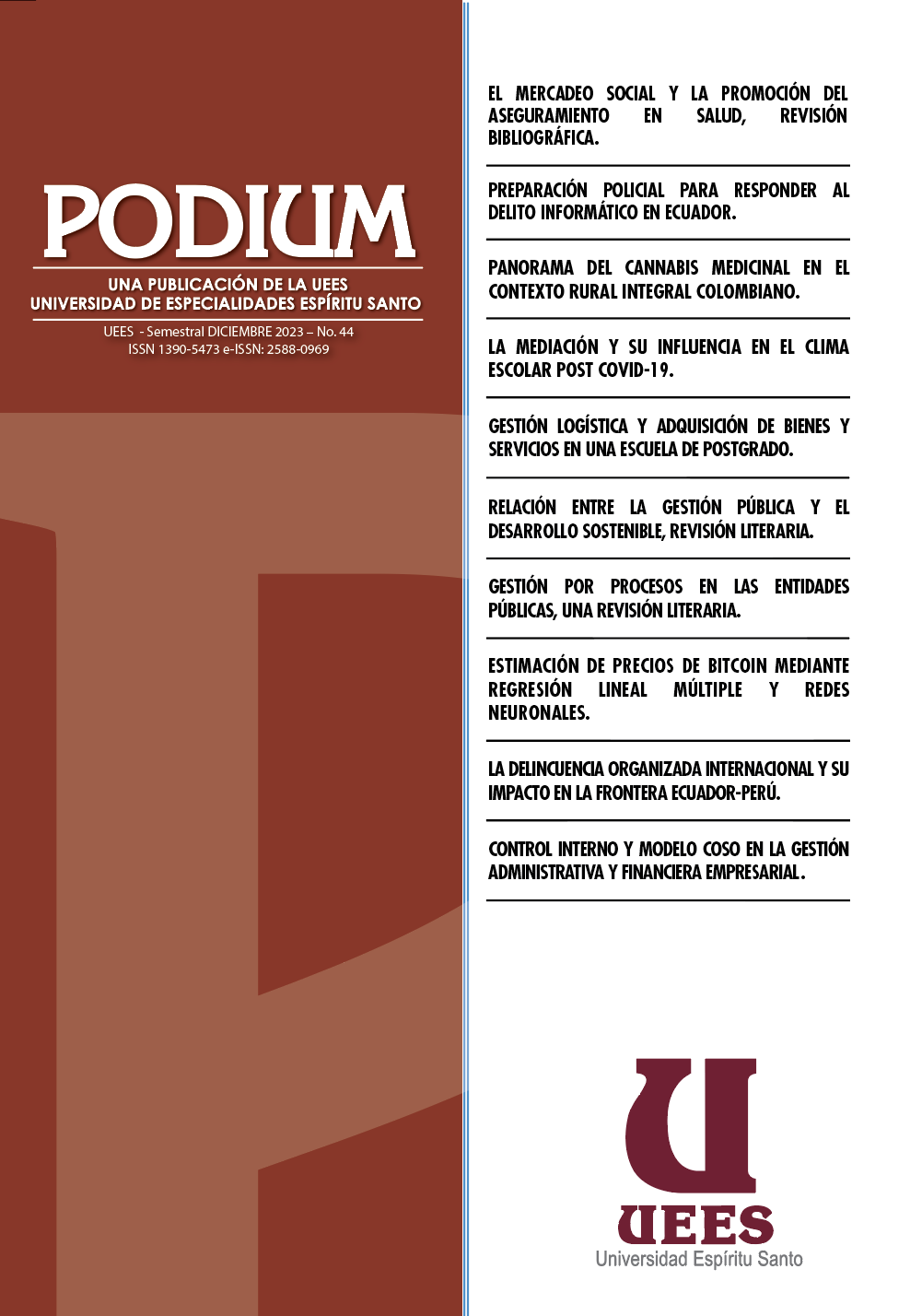Bitcoin Price Estimation using Multiple Linear Regression and Neural Networks
Main Article Content
Abstract
Various studies have focused on estimating the price of cryptocurrencies using time series models and static variables. This study focuses on Bitcoin price prediction, using a model that combines multiple linear regression and neural networks. This approach makes it possible to identify the factors that influence Bitcoin volatility and, through a dynamic selection of variables, to constantly detect the most relevant set of characteristics for prediction. Likewise, the amount of data is optimized to improve precision and avoid overuse of historical information. The combination of these techniques captures underlying patterns and trends, increasing the reliability of predictions, with an accuracy of 88%. However, it is crucial to consider the need for continuous evaluations to adapt to changing market conditions. This approach provides a more accurate tool for making informed decisions in a highly volatile market.
Downloads
Article Details

This work is licensed under a Creative Commons Attribution-NonCommercial 4.0 International License.
When an article is approved, the author or authors keep the rights or authorship and cede to PODIUM the right to be the first able to edit it, reproduce it, exhibit it and communicate it by printed or electronica media.
In order to reinforce our open access policy, PODIUM journal is published under a license named “Creative Commons Attribution-NonCommercial 4.0 International (CC-BY-NC 4.0)”. This license allows sharing (copying and redistributing the material in any means or format) and adapting (re-mixing, transforming, and creating starting from the material). Corresponding credits must be given and no commercial use of the materials is allowed.
Partial or complete reproduction of articles published in PODIUM is authorized, as long as the author is appropriately cited as the source and the reproduction has no commercial purposes.
References
Almeida, J., y Gonçalves, T. C. (2023). A Decade of Cryptocurrency Investment Literature: A Cluster-Based Systematic Analysis. International Journal of Financial Studies, 11(2), 71. https://doi.org/10.3390/ijfs11020071
Anamika, M. C., y Subramaniam, S. (2023). Does sentiment impact cryptocurrency? Journal of Behavioral Finance, 24(2), 202–218. https://doi.org/10.1080/15427560.2021.1950723
Balcilar, M., Bouri, E., Gupta, R., y Roubaud, D. (2017). Can Volume Predict Bitcoin Returns and Volatility? A Quantiles-Based Approach. Economic Modelling, 64, 74–81. https://doi.org/10.1016/j.econmod.2017.03.019
Chuang, C. C., Kuan, C. M., y Lin, H. Y. (2009). Causality in quantiles and dynamic stock return-volume relations. Journal of Banking and Finance, 33(7), 1351–1360. https://doi.org/10.1016/j.jbankfin.2009.02.013
Dey, P., Hossain, E., Hossain, M. I., Chowdhury, M. A., Alam, M. S., Hossain, M. S., y Andersson, K. (2021). Comparative analysis of recurrent neural networks in stock price prediction for different frequency domains. Algorithms, 14(8), 1–20. https://doi.org/10.3390/a14080251
Fama, E. F. (1970). Efficient Market Hypothesis: A Review of Theory and Empirical Work. The Journal of Finance, 25(2), 383–417. https://doi.org/10.2307/2325486
Fry, J., y Ibiloye, O. (2023). Towards a taxonomy for crypto assets. Cogent Economics and Finance, 11(1). https://doi.org/10.1080/23322039.2023.2207266
Georgoula, I., Pournarakis, D., Bilanakos, C., Sotiropoulos, D. N., y Giaglis, G. M. (2015). Using Time-Series and Sentiment Analysis to Detect the Determinants of Bitcoin Prices. SSRN Electronic Journal. https://doi.org/10.2139/ssrn.2607167
He, B., y Eisuke, K. (2021). The Application of Sequential Generative Adversarial Networks for Stock Price Prediction. The Review of Socionetwork Strategies, 15, 455–470. https://doi.org/10.1007/s12626-021-00097-2
Ivanovski, K., y Hailemariam, A. (2023). Forecasting the stock-cryptocurrency relationship: Evidence from a dynamic GAS model. International Review of Economics and Finance, 86(February 2022), 97–111. https://doi.org/10.1016/j.iref.2023.03.008
Kjærland, F., Khazal, A., Krogstad, E., Nordstrøm, F., y Oust, A. (2018). An Analysis of Bitcoin’s Price Dynamics. Journal of Risk and Financial Management, 11(4), 63. https://doi.org/10.3390/jrfm11040063
Kang, T. S., Joo, M. I., Kim, B. S., y Lee, T. G. (2022, February). Blockchain-based Lightweight Transaction Process Modeling and Development. In 2022 24th International Conference on Advanced Communication Technology (ICACT) (pp. 113-118). IEEE.Lahiani, A., Jeribi, A., y Boukef Jlassi, N. (2021). Nonlinear tail dependence in cryptocurrency and stock market returns: The role of Bitcoin futures. Research in International Business and Finance, 56. https://doi.org/10.1016/j.ribaf.2020.101351
Malkiel, B. G. (2004). Models of stock market predictability. Journal of Financial Research, 27(4), 449–459. https://doi.org/10.1111/j.1475-6803.2004.00102.x
Martínez, J., Améstica-Rivas, L., Parisi, A., y Gurrola, C. (2021). Predictor alternativo del precio de los activos financieros. El caso de la plata y el oro. Oikos Polis, Revista Latinoamericana, 30–54. http://www.scielo.org.bo/pdf/rlces/v6n2/v6n2_a04.pdf
Mohali, A., y Palm, F. (2021). Efecto de indicadores económicos adelantados sobre la predicción de precios de criptomonedas. Visión Gerencial, 1(21), 59–68. https://doi.org/10.53766/vigeren/2021.21.01.03
Parisi-Fernández, A., Améstica-Rivas, L., y Chileno-Trujillo, Ó. (2019). Predicción de variaciones en el precio del petróleo con el modelo de optimización ARIMA, innovando con fuerza bruta operacional. Tec Empresarial, 13(1), 53–70. https://doi.org/10.18845/te.v13i1.4302
Parisi, A., Parisi, F., y Díaz, D. (2006). Modelos de algoritmos genéticos y redes neuronales en la predicción de indices bursátiles asiáticos. Cuadernos de Economia - Latin American Journal of Economics, 43(128), 251–284. https://www.jstor.org/stable/41951551
Shen, D., Urquhart, A., y Wang, P. (2019). Does twitter predict Bitcoin? Economics Letters, 174, 118–122. https://doi.org/10.1016/j.econlet.2018.11.007
Smales, L. A. (2019). Bitcoin as a safe haven: Is it even worth considering? Finance Research Letters, 30, 385–393. https://doi.org/10.1016/j.frl.2018.11.002
Sun, X., Liu, M., y Sima, Z. (2020). A novel cryptocurrency price trend forecasting model based on LightGBM. Finance Research Letters, 32. https://doi.org/10.1016/j.frl.2018.12.032
Yao, Y., Li, X., y Li, Q. (2022). A Comparison on LSTM Deep Learning Method and Random Walk Model Used on Financial and Medical Applications: An Example in COVID-19 Development Prediction. Computational Intelligence and Neuroscience, 2022. https://doi.org/10.1155/2022/4383245
Ye, Z., Wu, Y., Chen, H., Pan, Y., y Jiang, Q. (2022). A Stacking Ensemble Deep Learning Model for Bitcoin Price Prediction Using Twitter Comments on Bitcoin. Mathematics, 10(8). https://doi.org/10.3390/math10081307





